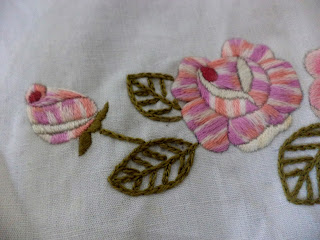I have not started any new embroidery project recently (although I have a very long wish list of projects) as I have decided not to do so without completing the old
projects that have been pending for a long time. Therefore at present I am continuing with only two unfinished projects.
Out of my experience, I would like to share a few tips on how to see some progress on your embroidery project:
1.
Never start an embroidery project that is too big and too time-consuming unless you are sure you can spend considerable time for the
project. Because with a long-pending embroidery project there are chances that the fabric and threads
may become old, you may lose some threads, and the pattern you transferred may fade away. You will also lose interest in your project in the course of time if it has been pending for long.
3. Prepare a schedule for your embroidery project like 30 minutes a day, and try to stick to it. It is okay to finish only a flower or a leaf in a week's time than not making any progress at all. I used to complain that I don't get time for embroidering. But of late I have included embroidery into my daily schedule, because I enjoy doing it. So try to squeeze in as much time as possible from your daily schedule (even 20 mins will help to make a little progress).
4. Most importantly, never concentrate on more than two projects at the same time. If you do more projects at the same time, there are chances that you may get confused doing many projects at the same time, and you can't concentrate or make progress with any one of those projects. I have done this many a times. (Experience speaks 😀)
5.
Long and short (needlepainting) embroidery projects may consume more time and need more
concentration. Therefore try to do an easy project along with a long and short embroidery project.
6. Make sure you don't get distracted often with social media (designate a time for social media like for 30 minutes a day), and also don't start your embroidery when your household is busy and when you spend time with your family. Try to do your projects without any hurry when you find some quiet time for yourself in the day. It may be early in the morning, mid-morning after kids left for school, in the afternoon when your baby takes a nap, or before bed time. You can designate some extra time for embroidering during weekends.
7. Designate a box or basket for each of the embroidery project you are doing, so that you won't lose your thread, needle, etc. Also make sure you have got enough threads for the entire project. This way you will avoid running out of threads. Also note down the list of thread colors used in the project in a piece of paper and keep it inside the box, so even if you are running out of any color shade, you can easily refer to the list.








